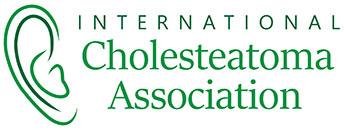Below is a glossary of words typically used when talking about cholesteatoma and treatment options. Medical staff can use all sorts of jargon which you may not have heard before of understand.
Canal wall down procedure
a procedure where the bony partition between the back part of the ear canal and mastoid is removed to create a mastoid cavity. This mastoid cavity is accessible for cleaning and identifying recurrences during outpatient visits.
Canal wall up procedure
a procedure where the bony partition between the back part of the ear canal and mastoid is kept intact. The cholesteatoma sac is removed through a combination of approaches through the mastoid bone and the ear canal.
Combined approach tympanoplasty
the combined approach refers to accessing the cholesteatoma through the ear and by drilling the mastoid bone while the back wall of the ear canal is left intact. Tympanoplasty is repairing the sound conduction mechanism, mainly by operating on the ear drum.
Conductive hearing loss
hearing loss due to a defect in the sound conduction mechanism.
Congenital cholesteatoma
a cholesteatoma that arises in an ear from skin that became trapped within the middle ear or mastoid cavity thought to be during the development of the baby.
DWI MRI
Diffusion-weighted imaging – Imaging techniques designed to weight the measured magnetic resonance imaging signal by the amount of diffusion (random thermal motion) of water molecules in the selected area
MRI
Magnetic resonance imaging. Use of magnetic resonance to create images of objects such as the body. Currently, this primarily involves imaging the distribution protons in the body.
Facial paralysis
this occurs when the facial nerve is exposed with erosion of its bony canal resulting in drooping of the face on that side
Glue ear
fluid accumulating in the middle ear, also called otitis media with effusion.
Keratin
a protein found in cells that form skin cells
Mastoid
the bone located directly behind the external ear which communicates with the middle ear
Mastoiditis
bacterial infection of the bones and air cells surrounding the ear (mastoid)
Mastoidectomy
a procedure to remove part of the mastoid in order to clean out infection and remove cholesteatoma
Modified radical mastoidectomy
a procedure where the diseased bone and choleteatoma is removed, preserving as many structures as possible (such as the hearing bones and ear drum) Reconstruction of the hearing bones and repair of the eardrum may also be performed at the same time.
Ossicles
the three bones behind the eardrum- malleus, incus and stapes
Ossicular reconstruction
a procedure to repair the ossicles (hearing bones) by rebuilding the bones or using prosthesis so that sound transmission can occur from the ear drum to the inner ear
Otalgia
pain sensations in the ear
Otorrhea
an ear with discharge
Otitis Media
infection of the middle ear
Petrous apex
a bone that is located deep to the inner ear
Petrous apex epidermoid
a cholesteatoma that arises from skin cells that became trapped within the inner ear
Radical mastoidectomy
a procedure where the eardrum, malleus and incus (two of the three hearing bones) are removed, and the bony partition between the back part of the ear canal and mastoid is also removed (canal wall down)
Retraction pockets
where the ear drum is sucked further into the ear due to negative pressure in the ear canal, and causes a pocket where skin cells can collect
Sclerotic
thicker bones inside the ear that have lost some of their air cells due to recurrent ear infections
Sensorinerual hearing loss
hearing loss due to damage to the inner ear
Squamous epithelium
top layer of the skin
Tinnitus
hearing noises in the ears such as ringing, roaring, clicks, whistles or hissing
Tympanoplasty
a procedure to repair the eardrum and hearing mechanism.
Vertigo
dizziness (sense of imbalance) which can be caused by inner ear erosion of semi-circular canal that controls the balance functions
External Links
Action on Hearing Loss have a glossary.
Healthline have produced a hearing animation on how the ear works.
The International Cholesteatoma Association is not responsible for the content of external websites.
